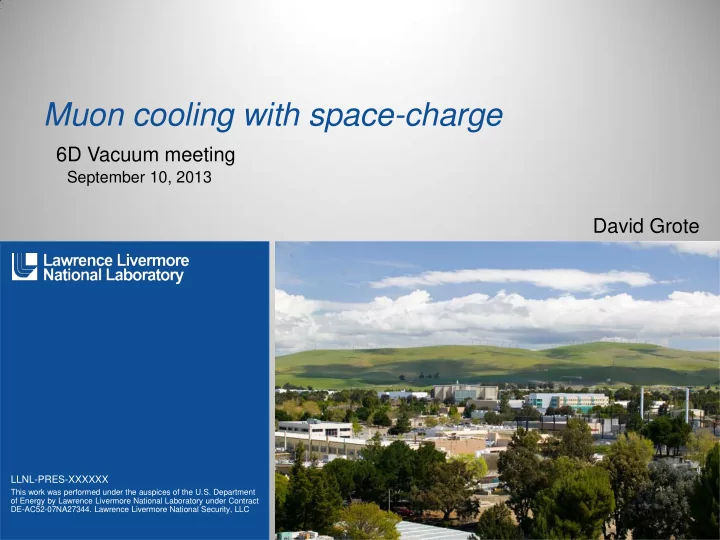

Muon cooling with space-charge 6D Vacuum meeting September 10, 2013 David Grote LLNL-PRES-XXXXXX This work was performed under the auspices of the U.S. Department of Energy by Lawrence Livermore National Laboratory under Contract DE-AC52-07NA27344. Lawrence Livermore National Security, LLC
Outline Overview of Warp Comparison to ICOOL Simulations with space-charge Conclusions Lawrence Livermore National Laboratory 2 LLNL-PRES-xxxxxx
Warp is a framework for particle accelerator modeling HIF/HEDP accelerators Multi-charge state beams Laser plasma acceleration LEBT – Project X Particle traps Electron cloud studies 2-D slab of electrons p+ bunches s Courtesy H. Sugimoto Alpha anti-H trap Paul trap e- clouds SPS - CERN Lawrence Livermore National Laboratory 3-D beam 3 LLNL-PRES-xxxxxx
Warp: a parallel framework combining features of plasma (Particle-In-Cell) and accelerator codes Geometry: 3D (x,y,z), 2-1/2D (x,y), (x,z) or axisym. (r,z) Python and Fortran: “ steerable, ” input decks are programs Field solvers: Electrostatic - FFT, multigrid; implicit; AMR R (m) Electromagnetic - Yee, Cole-Kark.; PML; AMR Boundaries: “ cut-cell ” --- no restriction to “ Legos ” Applied fields: magnets, electrodes, acceleration, user-set Z (m) Bends: “ warped ” coordinates; no “ reference orbit ” Warp 3D EM/PIC on Hopper Particle movers: Energy- or momentum-conserving; Boris, large time step “ drift-Lorentz ” , novel relativistic Leapfrog Surface/volume physics: secondary e - & photo-e - emission, gas emission/tracking/ionization , time-dependent space-charge-limited emission Parallel: MPI (1, 2 and 3D domain decomposition) Lawrence Livermore National Laboratory 4 LLNL-PRES-xxxxxx
Warp has proven useful to multiple applications HIFS-VNL (LBNL,LLNL,PPPL): ion beams and plasmas VENUS ion source (LBNL): beam transport LOASIS (LBNL): LWFA in a boosted frame FEL/CSR (LBNL): free e - lasers, coherent synch. radiation Anti H- trap (LBNL/U. Berkeley): model of anti H - trap U. Maryland: UMER sources and beam transport; teaching Ferroelectric plasma source (Technion, U. MD) : source Fast ignition (LLNL): physics of filamentation E-cloud for HEP (LHC, SPS, ILC, Cesr-TA, FNAL-MI): Warp-POSINST Laser Isotope Separation (LLNL): now defunct PLIA (CU Hong Kong) : pulsed line ion accelerator Laser driven ion source (TU Darmstadt) : source Magnetic Fusion (LLNL) : oblique sheath at tokamak divertor Lawrence Livermore National Laboratory 5 LLNL-PRES-xxxxxx
Warp reads and parses the ICOOL for001.dat input file This avoids human errors in the translation. Warp directly reads in the same forXXX.dat data files and ecalc9f.inp. Warp handles all fields and manipulations, except the muon-material interaction. For the interaction, Warp calls delta_ray and dedx from ICOOL. All ICOOL input not supported, but only that needed for the current simulations. Lawrence Livermore National Laboratory 6 LLNL-PRES-xxxxxx
The cooling lattice in Warp All pieces supported • RF cavities — Time dependent fields — Be windows, as absorbers and field boundary conditions • Cooling block — Wedge shaped — With windows • Solenoids • Beam, via macroparticles • Warp uses time as the independent variable — It relies on “residence corrections” for 2 nd order integration across boundaries. Lawrence Livermore National Laboratory 7 LLNL-PRES-xxxxxx
Simulations using RecFOFO lattice Lattice from Diktys, dated July 16, 2013 16 stages • 8 at 325 MHz • 8 at 650 MHz LH wedge absorbers Tilted solenoids Lawrence Livermore National Laboratory 8 LLNL-PRES-xxxxxx
Comparison to ICOOL – no space-charge Expect small differences • Different integrations – z versus t • Different diagnostics – Warp interpolates particles to diagnostic planes No decay e long ICOOL decay ICOOL no decay Warp decay N 0 e perp Decay Warp no decay Lawrence Livermore National Laboratory 9 LLNL-PRES-xxxxxx
Simulations with space charge Using electrostatics Simulations start with 1.25x10 13 muons Volts Volts Lawrence Livermore National Laboratory 10 LLNL-PRES-xxxxxx
Muon cooling with space-charge Little effect on emittance Increase in loss – out the bunch ends. e long ICOOL (no space-charge) N 0 Warp (space- e perp charge) Lawrence Livermore National Laboratory 11 LLNL-PRES-xxxxxx
More diagnostics with space charge ICOOL (no space-charge) Warp (space-charge) Lawrence Livermore National Laboratory 12 LLNL-PRES-xxxxxx
Effect of increased RF gradient – an easy knob to turn Previous simulations showed (RZ) reduced particle loss. Here, however, little effect is seen on N 0 . ICOOL Warp: e long +0 kV +1.5 kV N 0 +3.0 kV e perp +6.0 kV +7.5 kV +20. kV Lawrence Livermore National Laboratory 13 LLNL-PRES-xxxxxx
Conclusions Warp is setup to simulate muon cooling. Good agreement found with ICOOL (without space-charge). For the RecFOFO design, the effect of space- charge is small – but increasing particle loss. Hopefully, Warp can continue to be useful for the MAP project – unfortunately it looks like there may be no funds available in FY14. Lawrence Livermore National Laboratory 14 LLNL-PRES-xxxxxx
Recommend
More recommend